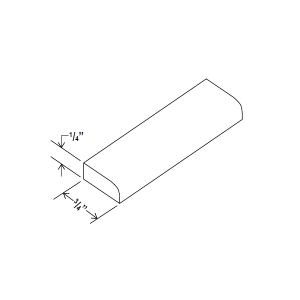
Fillet: Small, flat band separating two surfaces, or between the flutes of a column. Also: egg and tongue, egg and anchor, egg and star. Egg-and-dart: egg shapes alternating with V-shapes one of the most widely used classical mouldings. Echinus: Similar to the ovolo moulding and found beneath the abacus of the Doric capital or decorated with the egg-and-dart pattern below the Ionic capital. Drip cap: Moulding placed over a door or window opening to prevent water from flowing under the siding or across the glass. Dentils: Small blocks spaced evenly along the bottom edge of the cornice. When the concave part is uppermost, it is called a cyma recta but if the convex portion is at the top, it is called a Cyma reversa (See diagram at Ogee.) When crowning moulding at the entablature is of the cyma form, it is called a cymatium. Cyma: Moulding of double curvature, combining the convex ovolo and concave cavetto. General term for any moulding at the top or "crowning" an architectural element. Crown moulding: Wide, sprung moulding that is used at the junction of an interior wall and ceiling. Cove moulding or coving: Concave-profile moulding that is used at the junction of an interior wall and ceiling. Cornice: Generally any horizontal decorative moulding. Corner guard: Used to protect the edge of the wall at an outside corner, or to cover a joint on an inside corner. Chin-beak: Concave quarter-round moulding, rare in ancient buildings, more common today. Chamfer: Beveled edge between two adjacent surfaces. Chair rail or dado rail: Horizontal moulding placed part way up a wall to protect the surface from chair-backs, and used simply as decoration. It forms the crowning feature of Egyptian temples and took the place of the cymatium in many Etruscan temples. Cavetto: (in Italian) cavare ("to hollow"): Concave, quarter-round moulding sometimes employed in the place of the cymatium of a cornice, as in the Doric order of the Theatre of Marcellus. Cartouche (in French) escutcheon: Framed panel in the form of a scroll with an inscribed centre, or surrounded by compound mouldings decorated with floral motifs. Casing: Finish trim around the sides of a door or window opening covering the gap between finished wall and the jam or frame it is attached to. Cabled fluting or cable: Convex circular moulding sunk in the concave fluting of a classic column, and rising about one-third of the height of the shaft. Cable moulding or ropework: Convex moulding carved in imitation of a twisted rope or cord, and used for decorative mouldings of the Romanesque style in England, France and Spain and adapted for 18th-century silver and furniture design ( Thomas Sheraton). SCRIBE MOULDING FREE
It can leave an inset panel free to expand or contract with temperature and humidity. It will sometimes have a rabbet on its underside the depth of the lower level so it can lay flat over both. Bolection: Raised moulding projecting proud of a face frame at the intersection of the different levels between the frame and an inset panel on a door or wood panel.Bed moulds can be either sprung or plain, or flush to the wall as an extension of a cornice mould. Similar to crown moulding, a bed mould is used to cover the joint between the ceiling and wall. Bed-mould or bed moulding: Narrow moulding used at the junction of a wall and ceiling, found under the cornice, of which it is a part.Beak: Small fillet moulding left on the edge of a larmier, which forms a canal, and makes a kind of pendant.Other forms: Bead and leaf, bead and reel, bead and spindle.Beading or bead: Moulding in the form of a row of half spherical beads, larger than pearling.Bead moulding: Narrow, half-round convex moulding, when repeated forms reeding.Batten or board and batten: Symmetrical moulding that is placed across a joint where two parallel panels or boards meet.A "speed base" makes use of a base "cap moulding" set on top of a plain 1" thick board, however there are hundreds of baseboard profiles.
 Baseboard, "base moulding" or "skirting board": Used to conceal the junction of an interior wall and floor, to protect the wall from impacts and to add decorative features. It is also called a tenia (from Greek ταινία an article of clothing in the form of a ribbon). Bandelet: Any little band or flat moulding, which crowns a Doric architrave. When enriched with ornaments, it was also called chapelet. Baguette: Thin, half-round moulding, smaller than an astragal, sometimes carved, and enriched with foliages, pearls, ribbands, laurels, etc.
Baseboard, "base moulding" or "skirting board": Used to conceal the junction of an interior wall and floor, to protect the wall from impacts and to add decorative features. It is also called a tenia (from Greek ταινία an article of clothing in the form of a ribbon). Bandelet: Any little band or flat moulding, which crowns a Doric architrave. When enriched with ornaments, it was also called chapelet. Baguette: Thin, half-round moulding, smaller than an astragal, sometimes carved, and enriched with foliages, pearls, ribbands, laurels, etc. 

Astragal: Semi-circular moulding attached to one of a pair of doors to cover the gap where they meet.Archivolt: Ornamental moulding or band following the curve on the underside of an arch.Moldings from 1728 Table of architecture in the Cyclopedia







 0 kommentar(er)
0 kommentar(er)
